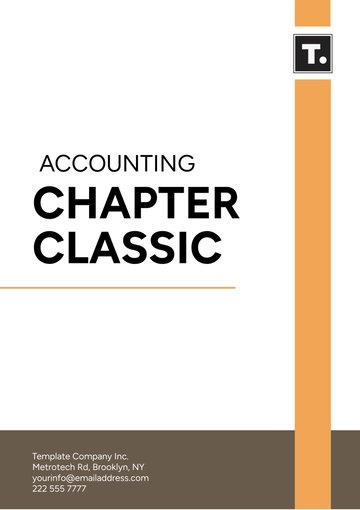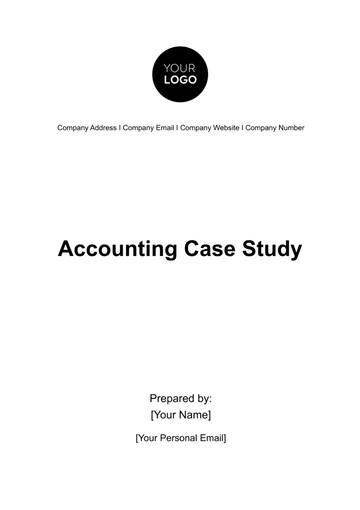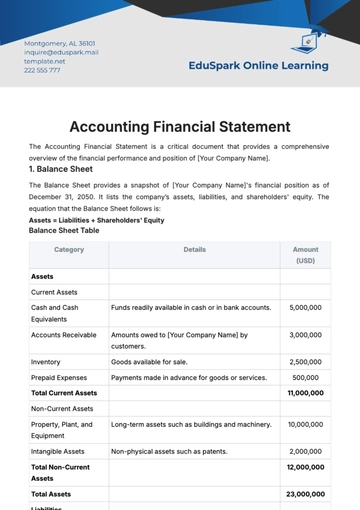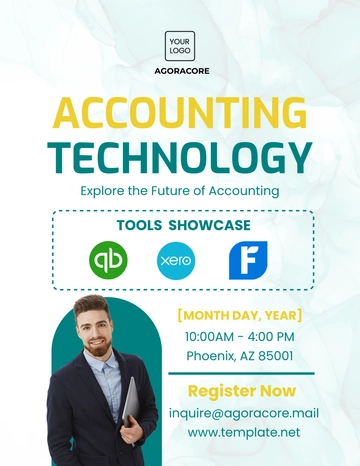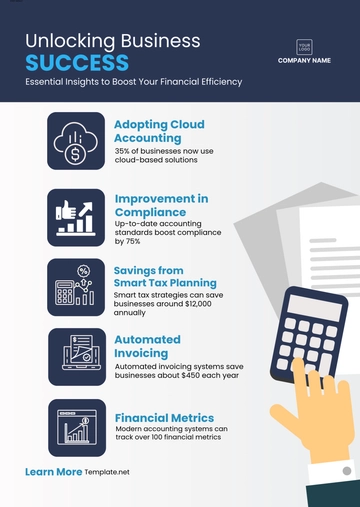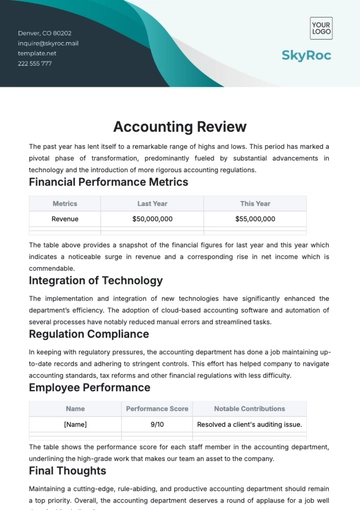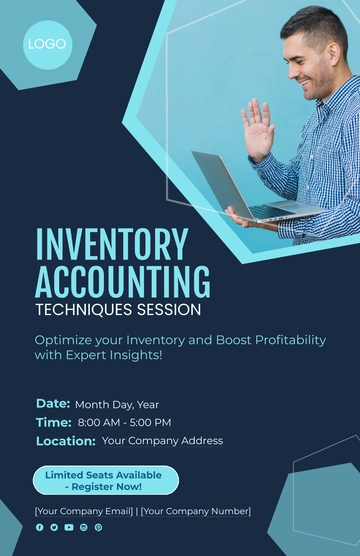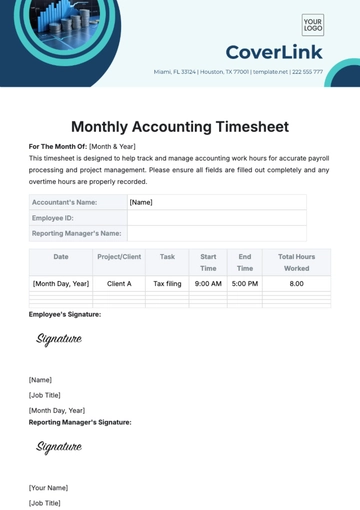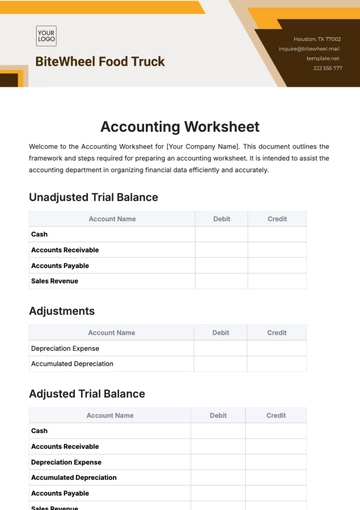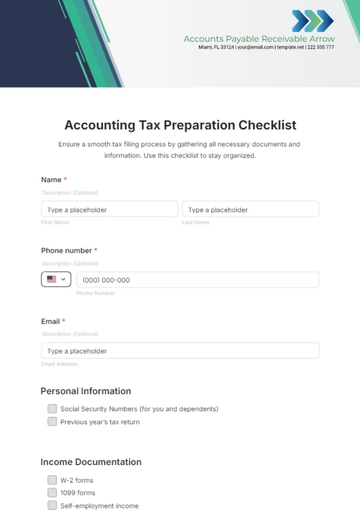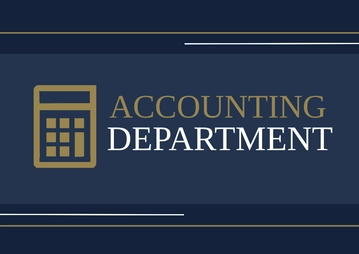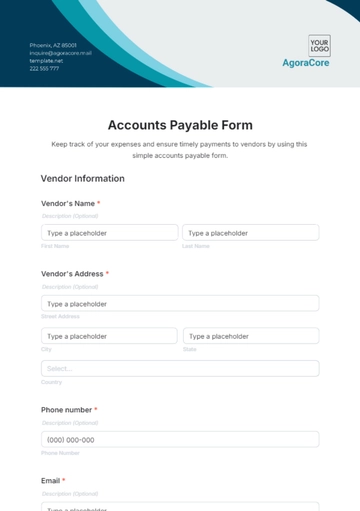Free Accounting Strategic Asset Management Document
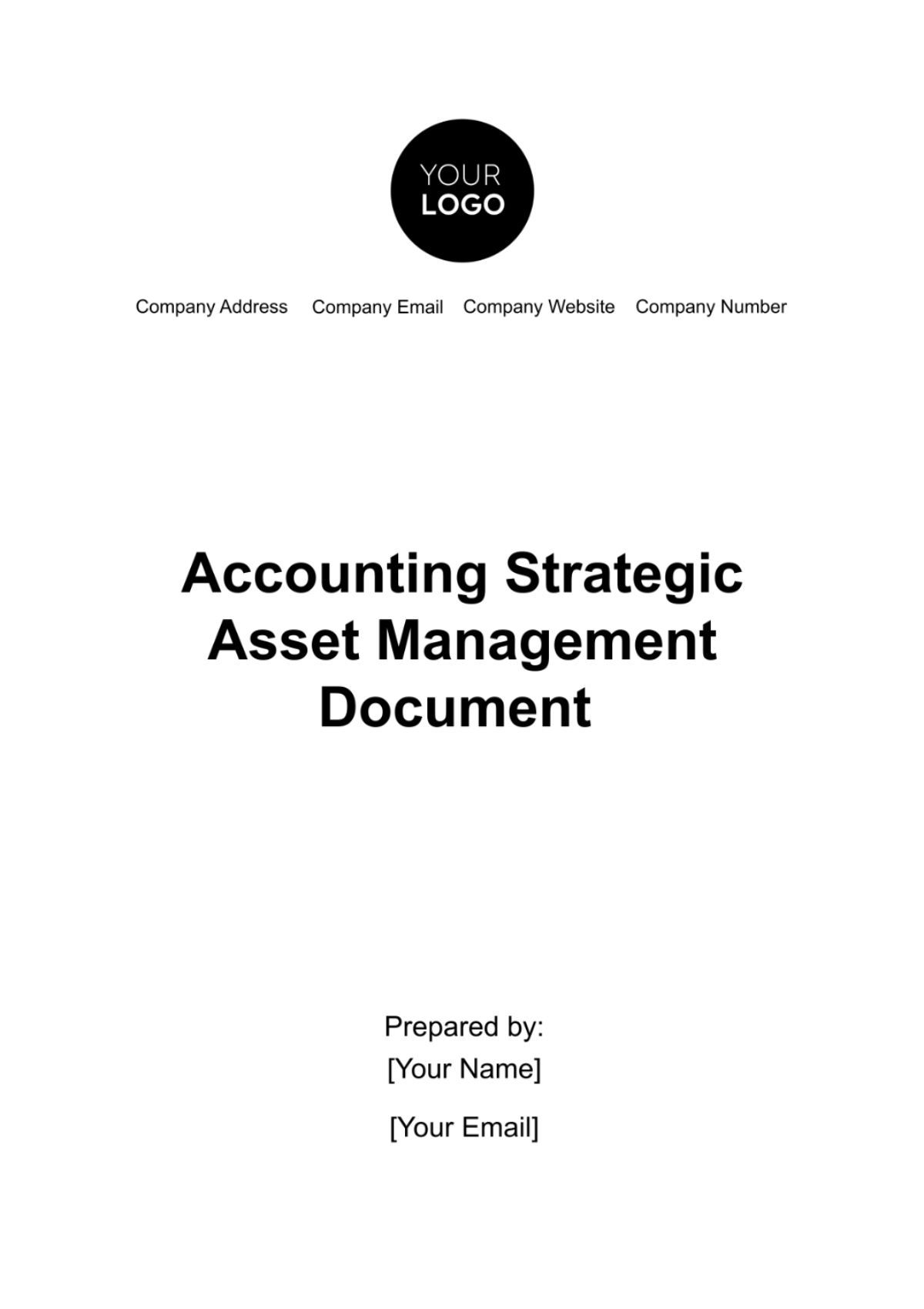
I. Introduction
A. Importance
The effective management of assets is paramount for [Your Company Name] to achieve its financial objectives. Strategic asset management not only optimizes financial performance but also ensures compliance with accounting standards and enhances decision-making processes. By focusing on the strategic aspect of asset management, the organization can unlock opportunities for increased efficiency, improved transparency, and ultimately, heightened profitability.
B. Scope
Asset Inventory and Classification
Conducting a thorough inventory of all company assets.
Classifying assets based on their nature, usage, and financial importance.
Valuation and Depreciation
Implementing standardized methods for asset valuation.
Establishing depreciation schedules and methods to accurately reflect asset values over time.
Integration with Accounting Systems
Integrating asset management processes with existing accounting systems.
Ensuring seamless communication between asset management and accounting departments.
C. Target Audience
Financial and Accounting Teams
Professionals responsible for financial reporting and adherence to accounting standards.
Accounting teams involved in the valuation, depreciation, and tracking of company assets.
Asset Management Personnel
Individuals tasked with the day-to-day management, tracking, and classification of company assets.
Those involved in the selection and customization of asset management software.
Decision-makers and Stakeholders
Executives and decision-makers using asset-related insights for strategic planning.
Stakeholders interested in understanding how effective asset management contributes to organizational success.
II. Objectives
The objectives of this guide are:
A. Streamlining Asset Management Processes
Develop streamlined processes for the management of assets to improve efficiency.
Reduce manual intervention and enhance automation for accuracy in asset tracking.
B. Ensuring Compliance with Accounting Standards
Implement practices to ensure compliance with accounting standards in asset valuation and reporting.
Establish a system for regular audits to verify adherence to financial regulations.
C. Maximizing Return on Investment (ROI)
Strategically manage assets to maximize ROI.
Implement methods for evaluating the performance of assets and making data-driven decisions.
III. Methodology
A. Asset Inventory and Classification
Conducting a comprehensive Asset Inventory involves the identification and cataloging of all company assets. This extends beyond physical assets to encompass financial instruments and intellectual property. The goal is to create a detailed repository that serves as the foundation for informed decision-making.
Identification
Begin by identifying and documenting each asset, ensuring that nothing is overlooked.
Categorization
Classify assets based on their nature, whether tangible or intangible, and further categorize by usage and financial significance.
Documentation
Document relevant details for each asset, including acquisition date, current condition, and any associated liabilities.
B. Valuation and Depreciation
Asset Valuation is a critical component, ensuring that assets are accurately represented on the balance sheet. The objective is to determine the fair market value, providing a realistic assessment of their financial worth.
Fair Market Value
Assess assets in accordance with prevailing market conditions, taking into account factors such as supply and demand. This evaluation ensures that the recorded value reflects the current economic landscape, providing a realistic representation of asset worth.
Asset Conditions
Examine the physical state and operational functionality of assets. Adjust valuations based on their conditions, recognizing that assets in optimal working order may retain higher values compared to those exhibiting wear or functionality issues.
Depreciation Calculation
The establishment of a Depreciation Schedule is crucial for acknowledging the gradual reduction in asset value over time. Employing recognized methods such as the Straight-Line Method or the Declining Balance Method allows for a systematic and accurate representation of an asset's diminishing value throughout its lifecycle.
Methods for Depreciation
Straight-Line Method allocates an equal amount of depreciation each year.
Declining Balance Method accelerates depreciation, with higher amounts in the earlier years.
C. Integration with Accounting Systems
Selecting Compatible Asset Management Software
Evaluate and choose asset management software that seamlessly integrates with existing accounting systems. Compatibility is crucial for ensuring that data flows smoothly between the asset management and accounting departments.
Customizing Software for Organizational Needs
Tailor the selected software to align with the specific requirements and structure of the organization. Customization ensures that the software effectively meets the unique needs of the accounting and asset management processes.
Employee Training and Onboarding
Prioritize comprehensive training programs for employees on the use of integrated software. Smooth onboarding processes will equip staff with the skills necessary to navigate the integrated system efficiently, promoting a cohesive workflow between accounting and asset management teams.
IV. Technology and Tools
A. Selection of Asset Management Software
The careful selection and integration of asset management software play a pivotal role in enhancing efficiency, accuracy, and overall effectiveness in managing assets. Below, we present a detailed overview of the chosen software solutions, emphasizing their key features and customization options to meet the specific needs of the company:
Software Name | Vendor | Key Features | Customization Options |
|---|---|---|---|
Asset Pro 2.0 | Tech Solutions | Real-time Asset Tracking | Customizable Dashboards |
Asset Pro 2.0, provided by Tech Solutions, offers real-time asset tracking capabilities, allowing the company to monitor the location and status of assets at any given moment. The software stands out with its real-time tracking feature, allowing the company to maintain a dynamic view of asset movements. This not only enhances security measures but also facilitates quick decision-making based on the current status of critical assets. Customizable dashboards contribute to user-friendly interactions, ensuring that employees can access relevant information efficiently. The software's ability to provide insights into asset utilization aligns with the organization's goal of maximizing ROI by optimizing the use of assets.
The selection of appropriate asset management software is pivotal for the company in establishing a streamlined approach to asset management. These tools not only enhance efficiency in tracking and monitoring but also contribute to accurate financial reporting. Integration capabilities with existing systems ensure a cohesive flow of data between asset management and accounting, reducing manual efforts and minimizing errors. Overall, investing in advanced technology aligns with the organization's commitment to leveraging modern solutions for improved financial processes.
B. Onboarding Process
A streamlined onboarding process is vital for ensuring a quick and effective adaptation of employees to the newly implemented asset management software. The diagram below details the strategies employed to facilitate a smooth onboarding experience:
The onboarding process is meticulously designed to facilitate a seamless transition for employees adapting to the newly implemented asset management software. Commencing with a detailed walkthrough, employees are provided with a comprehensive introduction to the software interface, emphasizing key features. Subsequent steps involve practical demonstrations to enhance understanding, hands-on practice sessions for familiarity, and guidance on potential challenges. The final step ensures employees have access to additional resources such as user manuals and FAQs, providing ongoing support. This systematic onboarding approach aims to empower employees, reducing resistance to change, and promoting a quick and effective assimilation of the asset management technology into their workflows. It serves as a critical component in optimizing the utilization of the chosen software and contributing to the overall success of the company's asset management strategy.
V. Compliance and Regulatory Adherence
A. Regular Compliance Audits
To uphold financial integrity and ensure alignment with accounting standards and regulations, regular compliance audits stand as a cornerstone. Conducting periodic reviews allows for a comprehensive evaluation of adherence to established financial norms, identifying any areas of non-compliance promptly.
Audit Frequency
Scheduled audits at predefined intervals provide a systematic approach to reviewing compliance. Regularity ensures that any discrepancies are promptly identified and rectified.Documentation Review
During audits, meticulous scrutiny of financial documentation is conducted, ensuring that records align with regulatory requirements. This process contributes to the creation of a robust audit trail.Prompt Issue Resolution
In the event of identified non-compliance issues, swift and targeted resolution strategies are implemented. This proactive approach minimizes the impact of non-compliance on financial processes.
B. Data Security and Privacy Measures
As technology advances, securing sensitive asset information becomes paramount. Robust data security measures are implemented to protect confidential information, and adherence to data privacy regulations is enforced.
Encryption Protocols
Cutting-edge encryption protocols are employed to safeguard asset information during storage and transmission. This ensures that sensitive data remains confidential and protected against unauthorized access.Regulatory Compliance
Stringent adherence to data privacy regulations, such as GDPR and others relevant to the industry, forms a foundational aspect of data security. The organization prioritizes compliance to mitigate legal risks.User Training on Security Practices
Educating employees on security best practices fosters a culture of awareness. Training programs equip staff with the knowledge to recognize and address potential security threats.
C. Risk Management Strategies
Incorporating risk management strategies within compliance and regulatory adherence further fortifies the organization against unforeseen challenges. Identifying potential risks associated with compliance and data security allows for proactive mitigation measures.
Risk Identification
Comprehensive risk assessments are conducted to identify potential threats to compliance and data security. This involves analyzing internal and external factors that may pose risks to financial processes.Mitigation Planning
In-depth planning for risk mitigation is an integral aspect. Strategies are developed to address and minimize the impact of identified risks, ensuring continued compliance and data security.Contingency Measures
Establishing contingency measures for unforeseen challenges provides a safety net. This ensures that the organization can respond effectively to unexpected events that may affect compliance and data security.
VI. Reporting and Analysis
A. Customized Reporting
Customized reporting is a cornerstone of effective communication in asset management. Tailoring reports to cater to the unique needs of various stakeholders ensures that the information presented is not only relevant but also actionable.
Stakeholder-specific Reports
Crafting reports specific to stakeholders ensures that each group receives information pertinent to their responsibilities. This targeted approach enhances the usefulness of the information presented.Key Performance Indicators (KPIs)
The inclusion of key performance indicators provides a quantitative measure of asset management success. Tracking KPIs offers a quick and standardized way to assess the health of asset-related processes.Real-time Reporting
Real-time reporting capabilities are integrated to offer timely insights. This ensures that decision-makers have access to the latest information, facilitating proactive decision-making based on current data.
B. Data Analysis for Decision-making
The utilization of advanced data analysis tools transforms raw data into actionable insights. This data-driven approach is pivotal for strategic decision-making in asset management.
Utilization of Analytical Tools
Deploying sophisticated analytical tools allows for in-depth examination of large datasets. This includes predictive analysis, trend identification, and performance assessments, providing a comprehensive view.Decision Support Systems
Implementing decision support systems based on data analysis findings enhances the decision-making process. These systems not only offer insights but also provide recommendations, aiding in informed decision-making.Continuous Improvement through Analysis
Beyond immediate decision-making, data analysis contributes to continuous improvement. Insights derived from analysis serve as a guide for refining strategies and optimizing asset management processes over time.
C. Performance Metrics Tracking
Establishing robust metrics for evaluating the performance of asset management processes is integral to understanding efficiency and effectiveness.
Scheduled Performance Metrics Reviews
Regularly scheduled reviews of performance metrics provide a structured approach to assessing the effectiveness of asset management strategies. This ensures ongoing evaluation and refinement.Benchmarking Against Industry Standards
Benchmarking against industry standards allows the organization to gauge its performance relative to peers. This external perspective provides valuable insights for improvement.Adaptive Metrics Framework
An adaptive metrics framework allows for adjustments based on changing organizational goals and industry dynamics. This flexibility ensures that performance metrics remain relevant and aligned with objectives.
D. Predictive Analytics
The incorporation of predictive analytics enhances the organization's ability to anticipate future trends and potential challenges in asset management.
Forecasting Asset Trends
Predictive analytics tools analyze historical data to forecast future trends in asset performance. This forward-looking approach aids in proactive decision-making.Risk Anticipation and Mitigation
Anticipating potential risks through predictive analytics allows for proactive mitigation strategies. This pre-emptive approach minimizes the impact of unforeseen challenges.Resource Allocation Optimization
Predictive analytics informs optimal resource allocation by identifying patterns and trends. This strategic approach ensures that resources are allocated efficiently to support asset management goals.
E. User-friendly Data Visualization
Presenting complex asset-related data in a user-friendly visual format enhances comprehension and facilitates quicker decision-making.
Interactive Dashboards
User-friendly dashboards provide an interactive interface for exploring asset data. This visual representation simplifies complex information, making it accessible to a wider audience.Graphical Representation of Trends
Visualizing trends through charts and graphs allows stakeholders to quickly grasp patterns and anomalies. This graphical representation aids in making data-driven decisions.Customizable Visual Displays
Offering customizable visual displays allows users to tailor the presentation of data to their preferences. This flexibility enhances the user experience and encourages greater engagement with the information presented.
VII. Risk Management
A. Identification of Asset-related Risks
Identifying potential risks associated with different asset categories is a crucial aspect of comprehensive risk management. Adopting a holistic approach ensures a thorough understanding of the challenges that may impact asset management processes.
Holistic Risk Identification
The process begins with a comprehensive identification of risks across various asset categories. This approach avoids overlooking critical risk factors and provides a panoramic view of potential challenges.Proactive Risk Identification Techniques
Utilizing proactive techniques, such as scenario analysis and risk workshops, enhances the identification process. By foreseeing potential risks before they materialize, the organization can take preemptive measures.Regular Risk Reviews and Updates
Continuous monitoring through regular reviews and updates of asset-related risks ensures that the risk landscape is continually assessed. This dynamic approach accounts for changes in internal and external factors, keeping risk assessments current.
B. Mitigation Strategies
Proactively addressing identified risks is essential for safeguarding asset management processes. Effective mitigation strategies are tailored to the nature of identified risks.
Customized Mitigation Plans
Tailoring mitigation plans to the nature of identified risks ensures that strategies are specific and targeted. Customization enhances the effectiveness of risk response and aligns with the unique risk profile of the organization.Collaborative Risk Mitigation
Engaging relevant stakeholders in the development and execution of risk mitigation strategies promotes collaboration. By involving key players, the organization can tap into diverse expertise and perspectives to strengthen risk management.Continuous Monitoring of Mitigated Risks
Monitoring risks even after mitigation is essential for adaptive risk management. Continuous oversight ensures that the effectiveness of mitigation strategies is assessed over time, allowing for adjustments as needed.
C. Data Security and Privacy Measures
Implementing robust data security measures is imperative to protect sensitive asset information. Adherence to data privacy regulations in asset management practices is a priority.
Encryption Protocols
Implementation of advanced encryption protocols safeguards sensitive asset information. Encryption ensures that data is secure during transmission and storage, mitigating the risk of unauthorized access.Compliance with Data Privacy Regulations
The organization is committed to complying with data privacy regulations relevant to asset management practices. This includes adherence to industry-specific standards and regional data protection laws.User Access Controls
Implementing stringent user access controls adds an additional layer of security. This ensures that only authorized personnel have access to sensitive asset data, reducing the risk of internal security breaches.
D. Scenario Analysis for Emerging Risks
Conducting scenario analysis for emerging risks allows the organization to anticipate and prepare for potential challenges that may impact asset management in the future.
Identification of Emerging Trends
Scenario analysis involves identifying emerging trends and factors that may influence asset management. This proactive approach positions the organization to respond effectively to evolving circumstances.Simulation of Potential Scenarios
Conducting simulations of potential scenarios to assess their impact on asset management enables the organization to develop strategies to navigate future challenges.Integration with Strategic Planning
The insights gained from scenario analysis are integrated into the strategic planning process. By aligning risk considerations with strategic goals, the organization ensures a cohesive and resilient approach to asset management.
E. Contingency Planning
Establishing contingency plans for unforeseen challenges in asset management is a fundamental aspect of risk preparedness.
Identification of Key Contingencies
The organization identifies key contingencies that may disrupt asset management processes. This includes events such as system failures, natural disasters, or sudden market shifts.Resource Allocation for Contingencies
Allocating resources for contingencies involves planning for the necessary personnel, technology, and financial resources to address unforeseen challenges. This proactive approach minimizes downtime and disruptions.Regular Testing and Updates
Regular testing and updates of contingency plans are conducted to ensure their effectiveness. The organization recognizes the dynamic nature of risks and ensures that contingency plans evolve accordingly.
F. Legal and Regulatory Compliance
Adhering to legal and regulatory requirements is paramount in mitigating risks associated with non-compliance.
Regular Compliance Audits
Conducting regular audits ensures ongoing compliance with laws and regulations governing asset management. This systematic approach identifies any deviations and allows for prompt corrective action.Adaptation to Legislative Changes
Staying abreast of legislative changes related to asset management is a proactive stance. This ensures that policies and practices remain in alignment with evolving legal requirements.Documentation and Record-Keeping
Rigorous documentation and record-keeping practices are in place to demonstrate compliance. Transparent records are maintained, easily accessible for audits or regulatory reviews.
VIII. Continuous Improvement
A. Periodic Review and Evaluation
Conducting regular reviews of asset management processes is integral to maintaining operational efficiency and identifying areas for improvement.
Routine Process Assessments
Periodic reviews involve the assessment of routine asset management processes. This includes evaluating the effectiveness of existing workflows, identifying bottlenecks, and streamlining procedures for optimal performance.Feedback Integration
Gathering feedback from key stakeholders, including end-users and management, contributes to a comprehensive review process. Integrating diverse perspectives ensures a well-rounded understanding of the strengths and weaknesses in asset management.
Key Performance Indicator (KPI) Analysis
Utilizing key performance indicators (KPIs) is central to evaluating the health of asset management processes. Analyzing KPIs provides quantifiable insights into areas that require attention and improvement.
B. Technology Updates and Upgrades
Staying informed about advancements in asset management technology is essential for maintaining a competitive edge and ensuring the efficiency of operations.
Continuous Market Research
The organization remains vigilant through continuous market research to stay informed about emerging technologies in asset management. This proactive approach positions the company to adopt innovations that enhance efficiency.Strategic Technology Adoption
Strategic technology adoption involves selecting technologies that align with the organization's goals and objectives. This ensures that technological investments contribute to the overall effectiveness of asset management.Regular System Upgrades
Regular upgrades to existing asset management systems are prioritized. This includes implementing the latest features, addressing security vulnerabilities, and optimizing performance to meet evolving business needs.
- 100% Customizable, free editor
- Access 1 Million+ Templates, photo’s & graphics
- Download or share as a template
- Click and replace photos, graphics, text, backgrounds
- Resize, crop, AI write & more
- Access advanced editor
Optimize asset management strategies with our customizable Accounting Strategic Asset Management Document Template on Template.net! This editable document empowers you with insights and best practices. Customize effortlessly with the AI Editor Tool, ensuring a document that aligns with your strategic asset management goals. Guarantee strategic asset planning and documentation today!





